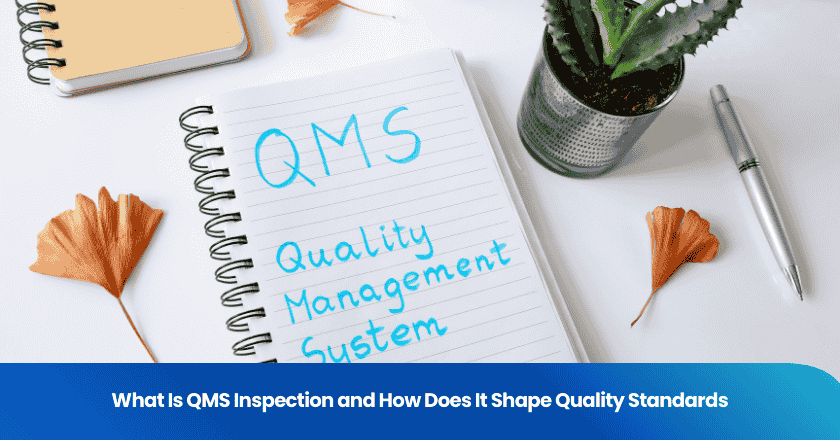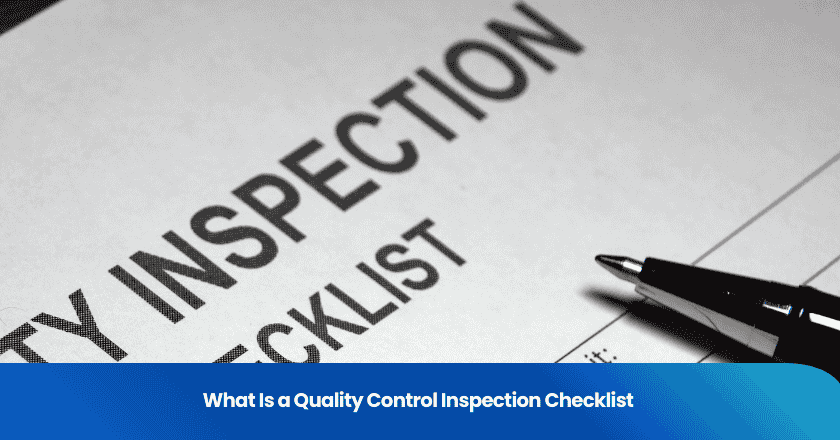
QMS inspection refers to a systematic process you use to evaluate and maintain the effectiveness of your quality management system. You see a shift toward ongoing readiness and risk-based approaches, driven by technology and evolving regulations.
QMS Inspection Overview
What Is QMS Inspection
You use qms inspection to evaluate and maintain the effectiveness of your quality management system. This process helps you ensure that your organization meets both internal standards and external regulations. QMS inspection covers every aspect of your operations, from product design to customer delivery. You rely on it to identify gaps, prevent defects, and drive improvements.
Quality inspection forms the backbone of this approach. You check processes, products, and systems to confirm that they meet established requirements. You do not treat this as a one-time event. Instead, you make it a continuous practice that supports your business goals.
Tip: You can use qms inspection to build a culture of accountability and excellence. When you embed inspection into daily routines, you reduce risks and improve outcomes.
How QMS Inspection Works
You start by defining clear quality standards for your organization. You then develop procedures to inspect and monitor every stage of your workflow. Quality inspection involves both manual checks and advanced technologies. You might use automated inspection systems to detect defects in real time. You can also deploy mobile robots or drones to reach areas that are difficult or unsafe for people.
Here is a table showing some of the technologies and tools you might use to facilitate qms inspection:
| Technology/Tool | Description |
|---|---|
| Automated Inspection Systems | Enhance quality control and ensure product specifications through precise measurement and defect detection. |
| Mobile and Autonomous Inspection Technologies | Utilize drones and mobile robots for inspecting hard-to-reach areas safely and efficiently. |
| Integration of IoT and Smart Sensors | Facilitate immediate insights and improve quality control systems through data analysis. |
| Predictive Maintenance | Use data analytics to predict potential equipment failures before they occur. |
| Remote and Virtual Inspections | Employ video conferencing and augmented reality for timely inspections, reducing travel costs. |
| AI and Data Analytics in Inspection | Leverage machine learning and historical data analysis to identify potential quality failures. |
You also use quality management systems to oversee and document every inspection. These systems help you track findings, assign corrective actions, and ensure accountability. Automated inspection systems, such as vision-based tools, allow you to spot defects quickly and accurately.
You may face challenges during implementation. Regulatory compliance complexities can overwhelm your team. Employee adoption and training issues may lead to errors. Data management problems can make it hard to analyze root causes. Outdated systems or inefficient processes can slow down your response to quality threats.
To measure the effectiveness of your qms inspection program, you follow a structured approach:
1. Identify the key factors that indicate the effectiveness of your processes.
2. Choose the correct measurement method for each factor.
3. Implement quality assurance processes.
4. Document measurement activities to standardize workflows.
5. Keep your policies and measurement methods updated according to the latest quality standards.
You also look to the future. Predictive quality analytics and AI-powered visual inspections are transforming how you manage quality inspection. These methods help you reduce defect rates and improve decision-making accuracy. Continuous compliance monitoring ensures you stay audit-ready and save costs.
You shape your organization’s quality culture by making qms inspection a daily habit. This approach helps you adapt to change, meet regulatory demands, and achieve business growth.
QMS Inspection Importance
Compliance and Regulatory Readiness
You face increasing regulatory demands in every industry. The importance of quality inspection grows as you strive to meet these requirements and avoid costly penalties. In 2025, you no longer rely on simple checklist inspections. You adopt a mindset of ongoing readiness, which means you prepare for inspection at any time, not just during scheduled audits. This approach helps you stay ahead of regulatory changes and maintain a strong reputation.
Quality inspection supports your compliance efforts by centralizing documentation and making it easy to retrieve during an inspection. You benefit from validated workflows that reduce errors and demonstrate control over your processes. Audit trails and data integrity features in your qms provide timestamped logs, which build trust with regulators. You also manage training compliance, ensuring your team meets all requirements. Real-time dashboards give you visibility into quality metrics, so you can address issues before they escalate. CAPA and deviation management workflows show that you handle nonconformances effectively. Mock audits and inspection preparation exercises help you identify gaps and train your staff for real-world scenarios.
Note: Ongoing inspection readiness protects your business from penalties that can range from $50,000 to $500,000, depending on compliance effectiveness. A comprehensive inspection readiness checklist can eliminate up to 89% of violation risks and reduce penalty exposure by 67%.
You must also understand the specific regulations that quality inspection helps you meet. The table below highlights some of the most common regulatory requirements:
| Regulation | Description |
|---|---|
| FDA 21 CFR Part 820 | Core U.S. regulation for medical device quality systems, covering management responsibility, design controls, and more. |
| EU MDR 2017/745 and IVDR 2017/746 | Requires a QMS covering the entire lifecycle of the device, including design, manufacturing, and post-market surveillance. |
| ISO 13485:2016 | International standard for medical device QMS, ensuring consistent meeting of customer and regulatory requirements. |
| ISO 14971 | Provides guidelines for risk management in medical devices, focusing on hazard identification and risk control. |
| MDSAP | Allows a single audit to meet the requirements of multiple regulatory authorities globally. |
You see that the importance of quality inspection extends beyond passing audits. It builds a foundation for regulatory readiness and long-term success.
Business Value and Risk Management
You recognize that qms inspection is not just about compliance. It drives business value and reduces risk across your operations. When you implement ongoing inspection readiness, you protect your business from unexpected costs and disruptions. For example, OSHA inspections can cost construction companies an average of $182,000 per violation when unprepared. Poorly managed compliance programs face 73% higher penalty rates and longer project delays. By achieving inspection readiness, you shield your operations from these risks and create a more resilient organization.
Quality inspection reduces business risk by ensuring you adhere to quality standards. This lowers the chance of errors and potential penalties. Streamlined operations lead to increased efficiency and lower costs associated with rework. When you harmonize risk-based thinking with ISO 9001, you support compliance with international quality standards. Pre-emptive detection of quality risks helps you avoid production delays and resource wastage.
You also strengthen business continuity through compliant quality processes. Optimized quality assurance saves you money on defects and rework. Systematic implementation of compliance protocols can generate annual savings of $275,000. You see that the importance of quality inspection lies in its ability to drive operational efficiency and support business growth.
- Centralized documentation makes inspection faster and easier.
- Validated workflows reduce errors and improve process control.
- Audit trails ensure data integrity and build trust.
- Training compliance keeps your team prepared.
- Real-time metrics enable proactive quality management.
- CAPA and deviation management show you resolve issues quickly.
- Mock audits prepare your staff for real inspections.
You use qms inspection to create a culture of accountability and excellence. This approach supports your quality management goals and positions your business for sustainable growth. Quality inspection becomes a strategic tool for risk management and operational success.
Quality Inspection Methods
Internal and External Audits
You rely on audits to strengthen your qms and maintain high standards in your quality inspection process. Internal audits use your own trained staff to review procedures and spot areas for improvement. External audits involve independent parties, such as regulators or consultants, who assess your compliance and may influence certifications or contracts.
The table below highlights key differences:
| Aspect | Internal Audits | External Audits |
|---|---|---|
| Conducted by | In-house QA staff or trained personnel | Independent parties (regulators, clients, consultants) |
| Frequency | More regular and responsive | Often mandatory, linked to certification or approvals |
| Results | Focus on corrective and preventive measures | Authoritative results based on compliance documentation |
| Environment | Lower-pressure, supports learning and improvement | Higher pressure, can influence licenses and contracts |
You schedule internal audits more frequently, especially in production areas, where reviews may occur monthly, weekly, or even daily. Non-operational areas often see annual audits. Factors such as regulatory frameworks, company size, and process risks shape your audit schedule.
ISO 13485 recommends auditing all key processes at least once every three years, with higher-risk processes reviewed annually or biannually. 21 CFR Part 820 suggests regular audits for areas like complaint handling and CAPA.
Process, Product, and System Checks
You use several types of checks to ensure your quality inspection process covers every aspect of your operations. Product audits evaluate finished goods to confirm they meet design specifications and customer requirements. Process audits examine workflows in real time, focusing on adherence to procedures and identifying inefficiencies. System audits assess the overall effectiveness of your qms, reviewing policies and documentation for compliance with standards such as ISO 9001.
- Product-based quality assurance checks if items meet physical standards.
- Process-based quality assurance monitors how things are made.
- System-based quality assurance looks at the entire operation.
- People-based quality assurance focuses on worker training and skills.
Quality assurance in manufacturing ensures products meet specified standards and customer expectations through stringent quality control measures. This systematic approach helps you prevent defects, maintain consistency, and optimize efficiency.
The QA framework is not a one-size-fits-all solution. You tailor it to your product or service, using quality control, planning, and improvement to meet customer expectations.
Tools and Techniques
You enhance your quality inspection process by using proven tools and digital solutions. Cause-and-effect diagrams help you determine root causes of problems. Check sheets assist in gathering and organizing data. Control charts measure process stability over time. Histograms map data distribution, while Pareto charts identify the most important problem areas. Scatter diagrams show relationships between variables, and flowcharts map processes neatly.
Cloud-based inspection software offers customizable checklists, photo capture, real-time data entry, and automated reporting. You benefit from centralized data management, which tracks real metrics and delivers actionable insights. Automation streamlines repetitive tasks, reducing human error and improving accuracy. Secure digital platforms enable remote inspections and provide a centralized place to store and review records, accelerating issue resolution.
You create a transparent, responsible, and audit-ready inspection environment by leveraging these tools and techniques in your qms.
Shaping Quality Standards
Continuous Improvement
You drive higher standards in your organization by making quality inspection a foundation for continuous improvement. You do not wait for annual audits. Instead, you use regular inspection as a feedback loop that measures qms success, ensures compliance, and highlights areas for improvement. You engage your team in analyzing performance data and identifying corrective actions. This approach fosters a culture of accountability and ongoing enhancement.
You often integrate proven continuous improvement models with your qms inspection process, such as:
- Lean
- Six Sigma
- Plan-Do-Check-Act (PDCA) cycle
These models help you streamline workflows, reduce waste, and maintain a focus on quality assurance every day.
Real-World Benefits
You see measurable benefits when you embed quality inspection into your daily operations. For example, a pharmaceutical manufacturer resolved a recurring contamination issue by using the CAPA process. They identified improper sterilization, halted production, retrained staff, and upgraded equipment. This proactive response improved patient safety and protected the company’s reputation.
In construction, you use qms to track compliance and automate reporting. On large projects, such as the London Underground, Construction Inspection Reports document adherence to design specifications. This real-time tracking leads to safer, more efficient projects.
Adapting to Change
You adapt your qms inspection process to meet new regulatory and market demands. You respond to updated inspection models, additional labeling requirements, and a shift from checklist audits to holistic quality assessments. You plan audits with qualified personnel and maintain meticulous documentation. You also emphasize risk-based controls and robust internal audit records.
Modern electronic qms platforms support compliance and enhance data integrity. You streamline processes to meet new requirements and maintain inspection readiness as a daily standard. You achieve this by:
1. Maintaining well-trained personnel
2. Organizing documentation systematically
3. Fostering a strong quality culture with clear expectations
You see that quality inspection is not just for audits. It becomes a daily practice that shapes industry standards and drives continuous improvement.
You see the role of QMS inspection evolving rapidly. Recent research shows that the quality management system now focuses on data integrity, risk management, and ongoing improvement. In 2025, you benefit from inspection readiness and a culture of continuous improvement. This approach helps you:
- Enhance operational efficiency
- Increase customer satisfaction
- Strengthen your brand reputation
- Reduce costly rework and compliance risks
You position your organization for long-term success by making QMS inspection a strategic, ongoing process.
FAQ
What is the main purpose of QMS inspection?
You use QMS inspection to verify that your processes meet quality standards. This helps you maintain compliance, prevent defects, and improve efficiency across your organization.
How often should you conduct QMS inspections?
You should schedule QMS inspections regularly. Many organizations perform internal audits monthly or quarterly. External audits may occur annually or as required by regulations.
Which industries benefit most from QMS inspection?
Industries such as manufacturing, healthcare, IT, and construction gain significant advantages from QMS inspection. You see improved compliance, reduced risk, and enhanced product quality.
What tools can you use for QMS inspection?
You can use automated inspection systems, cloud-based software, and data analytics platforms. These tools help you track findings, assign corrective actions, and maintain audit readiness.
How does QMS inspection support continuous improvement?
You use QMS inspection to identify areas for improvement. Regular feedback and corrective actions drive ongoing enhancement of your processes, helping you achieve higher quality standards.
Grow your business with TradeAider Service
Click the button below to directly enter the TradeAider Service System. The simple steps from booking and payment to receiving reports are easy to operate.


